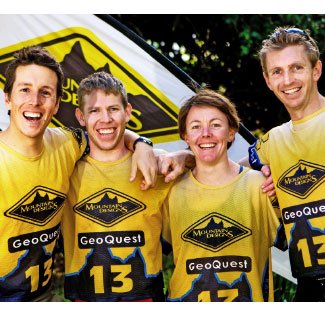Why adventure is really just bad planning

THE FAMOUS POLAR explorer Roald Amundsen said “adventure is just bad planning”. However, our resident adventure racing crew, Team Australian Geographic Outdoor (formerly known as Team Outdoor Australia), question that view after their experience in the GeoQuest 2009 — Australia’s premier adventure race.
Forty-eight hours of non-stop trekking, mountain biking and kayaking sounds like a significant undertaking. However, for the teams lining up at the start of the 2009 GeoQuest 48-hour adventure race, it is just the tip of the iceberg; the culmination of days of travel and competency checks, weeks of organisation and months of training.
Planning for a race like GeoQuest is an epic in itself. Leaving nothing to chance in a mission to race a bit faster than previous years, Team Australian Geographic Adventure — made up of Kimberlee Philip, Sean King, Andrew Renwick and Steve Burns — had fastidiously planned for this year’s race. Countless hours spent discussing strategies, holding team training sessions and writing up gear lists, food lists, transition lists and lists of lists. All in the aim of saving a few minutes at each transition and moving a few percent faster in each discipline. Sounds like small returns, but it makes a big difference in a race that is 200+ km long with nearly a dozen transitions.
Race morning finally arrived – the alarm clock buzzing us into the day at 5am. Time to put all that planning into action. The darkness of the campsite is broken by beams of light from powerful head torches as frenzied racers hurry to load bikes, pack bags, check instructions and make last minute adjustments to equipment. The camp resembles a lycra-themed rave party.
THE TWO-HOUR DRIVE from the camp to race start in the Barrington Tops gives an insight into what the teams can expect – networks of amazing lakes, golden coastlines, rolling green hills and overgrown forests.

Team Australian Geographic Outdoor
The teams are set off at ten second intervals. Waiting at the start line each second seems like an eternity. Finally the siren sounds and Team Australian Geographic Adventure are off.
The first bike leg is going to be fast – descending more than 1600 vertical metres. Everyone is pedaling furiously. Probably too furiously for a race this long – but adrenaline has that affect. Then, suddenly, it all goes horribly wrong. Andrew clips a large branch that is down across the track. Before he stops sliding he is run over by the chasing pack of riders.
The months of preparation are over before the first checkpoint. Forty minutes later the three remaining members of Team AGA see Andrew into one of the search and rescue vehicles. There is unanimous agreement to keep racing, but standing there as a group of three, unranked and in last place, there’s a sudden realisation that this year’s race is not going to play out as planned.
The team rides into the finish of the first leg just as dark falls. Support crew confirms what they expected – Andrew has broken his collar bone. It turns out to be one of many ‘not quite planned’ events which include a broken bike, a lost kayak paddle, a support vehicle running out of fuel, knee problems and a magnetic fastening system in the navigator’s life jacket wreaking havoc on navigation.
TRAVERSING THE BARRINGTON Tops State Forest by foot and bike – rogaining through near-impenetrable lantana around the upper reaches of the Bowman River, crossing the spectacular Copeland Range, blazing trails through lush farmland and slogging along muddy fire trails that turned featherweight racing bikes into machines that would have most motor-cross riders complaining about the weight. And that was just the first leg.
A spectacular kayak up the Wang River followed by an epic mountain bike and trek combination – the crux of the race for the teams at the pointy end of the field – marks the start of leg two. Brains and brawn are tested as teams construct rafts from car tubes to cross the southern end of the Myall Lake. For some it’s breaking point – a seemingly innocuous part of the course saw the slowest teams spending more than five hours wet and cold to cover what was by far the shortest section of the race at just 5.5km. After the rafts, kayaks felt like jet boats as the teams paddled the length of Myall Lake before carrying their boats to Smith Lake and paddling to its western shore. By the final run muscles scream, protesting at the added weight of backpacks loaded with wetsuits and tyre tubes.
Finally back into the kayaks for the paddle home; deliriously tired. The sun rises, the final check point is punched, dolphins play alongside boats and support crew cheer from the shores.
WHEN THE TEAM FINALLY hobbles across the finish line in Forster, 47 hours and 10 minutes after they set off (and 10 hours slower than they had planned), the excitement is palpable. That was truly awesome! Between Barrington and Forster the teams had ridden 113 km, paddled 61 km and trekked 46 km.
There’s something about struggling through adversity and succeeding, resulting in a feeling of euphoria. The sweet single track, the moonlight paddling, the long cross-country treks, that sinking ‘oh shit we’re lost’ feeling, the crudely assembled raft, two days and nights of non-stop racing… yep, that’s adventure. And, after all, that’s what all the teams are here for.
So perhaps Amundsen wasn’t quite right. Perhaps the saying should be more along the lines of ‘adventure is what happens when good planning goes wrong’.
Source: Australian Geographic Outdoor Sep/Oct 2009

